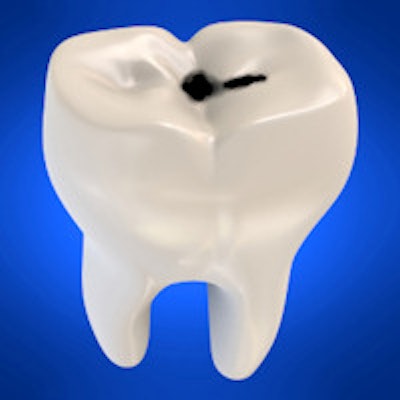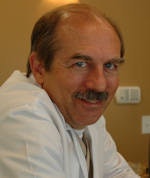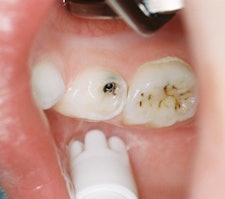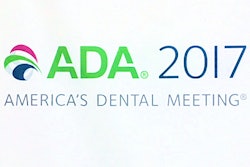
What if there were a treatment that would arrest caries and prevent further dental infection without traditional drilling and filling? There is: silver diamine fluoride (SDF), according to a new paper published in the Journal of the California Dental Association.
Until now, there has been no effective alternative treatment for dental caries in the U.S. besides restorations, according to the authors. But that may change after the U.S. Food and Drug Administration (FDA) classified SDF as a fluoride in 2014. SDF is an inexpensive topical treatment that is used extensively internationally to treat dental caries across the age spectrum, they noted.
"No other intervention approaches the ease of application and efficacy," wrote the authors, led by Jeremy Horst, DDS, PhD, of the University of California, San Francisco School of Dentistry (J Calif Dent Assoc, January 2016, Vol. 44:1, pp. 17-28). "Countless patients would benefit from conservative treatment of nonsymptomatic active carious lesions."
SDF is particularly suitable for children being treated in school who have more carious lesions than can be treated in one visit, they noted. Public health dentists who pushed for FDA clearance for SDF are now applying for a dental caries indication, they added.
"American dentistry has been desperately lacking an efficient instrument to be used at the diagnostic visit to provide a step toward controlling the disease," the authors wrote.
They conducted a systematic review, and since SDF has been cleared by the FDA for marketing as a class II medical device to treat tooth sensitivity, they discussed off-label use of it as a drug to treat and prevent dental caries, as well as clinical indications and protocol, in their paper.
SDF's 'zombie effect'
The fluoride in SDF promotes remineralization, while the silver in SDF acts as an antimicrobial agent. The treatment is applied topically and produces a squamous layer on the exposed dentin, which partially plugs the dentinal tubules, the authors explained.
"Silver diamine fluoride outperforms other anticaries medicaments in killing cariogenic bacteria in dentinal tubules," wrote the authors of a study published in the Australian Dental Journal (March 2015, Vol. 60:1, pp. 80-87).
 Steven Duffin, DDS.
Steven Duffin, DDS.When bacteria killed by silver ions are added to living bacteria, the silver is reactivated. The authors of another study noted that this reactivation means that, effectively, the dead bacteria kill the living bacteria in a "zombie effect" (Scientific Reports, April 23, 2015).
"The decision to categorize SDF as another fluoride product will lower the barriers to access to care for millions of high caries-risk people in America," Steven Duffin, DDS, told DrBicuspid.com. "Why drill when the infection is gone?"
Dr. Duffin, based in Keizer, OR, is a longtime advocate of SDF, and his experience using it on an off-label basis in his general practice was cited in a 2012 study (J Calif Dent Assoc, November 2012, Vol. 40:11, pp. 852-858).
“The decision to categorize SDF as another fluoride product will lower the barriers to access to care for millions of high caries-risk people in America.”
"I believe that the FDA approval for this product may be the most important development for dentistry that I have seen during my 35-year career," he said.
The authors of the current paper noted that the ADA did not mention SDF in its Council on Scientific Affairs reports on caries-preventive agents (Journal of the American Dental Association, December 2011, Vol. 142:9, pp. 1065-1071) and managing xerostomia (JADA, August 2014, Vol. 145:8, pp. 867-873), and SDF it is not part of standard dental school curricula.
Documentation for the treatment's effectiveness for stopping caries began in the 1800s, according to the authors. The material's well-noted drawback is that it produces a darkening of carious lesions, but that simply indicates they have successfully been arrested, they stated. It does not stain healthy enamel.
Better than fluoride varnish
The material also greatly outperforms fluoride varnish for caries arrest and is equivalent or better than glass ionomer cement, according to the authors. Applying SDF every year prevents many more carious lesions than quarterly application of fluoride varnish in both children and the elderly, they noted.
 Two teeth treated with silver diamine fluoride. The tooth on the right shows caries that have been arrested, while the tooth on the left shows arrested incipient caries. Image courtesy of Steven Duffin, DDS.
Two teeth treated with silver diamine fluoride. The tooth on the right shows caries that have been arrested, while the tooth on the left shows arrested incipient caries. Image courtesy of Steven Duffin, DDS.The authors recommended the following indications for treating caries with SDF:
- Extreme caries risk (xerostomia or severe early childhood caries)
- Treatment challenged by behavioral or medical management
- Patients with carious lesions that may not all be treated in one visit
- Difficult-to-treat dental carious lesions
- Patients without access to oral care
"The advent of a treatment for nonsymptomatic caries not requiring general anesthesia or sedation addresses long-standing concerns about the expense, danger, and practical complexity of these services," the authors wrote.
Dental hygienists and dental assistants are allowed to apply SDF in California to control caries as it is classified as a topical fluoride. Physicians, nurses, and their assistants also are permitted to apply fluorides in California and many other states and federal programs, according to the authors.
Additionally, a new code, D1354, was approved by the Code on Dental Procedures and Nomenclature Code Maintenance Commission for 2016 for "interim caries arresting medication application" to facilitate documentation and billing, they noted, adding that insurers are evaluating coverage for SDF treatments.
"Silver diamine fluoride is a safe, effective treatment for dental caries across the age spectrum," the authors concluded. "This as a powerful new tool in the fight against dental caries, particularly suited for those who suffer most from this disease."



















